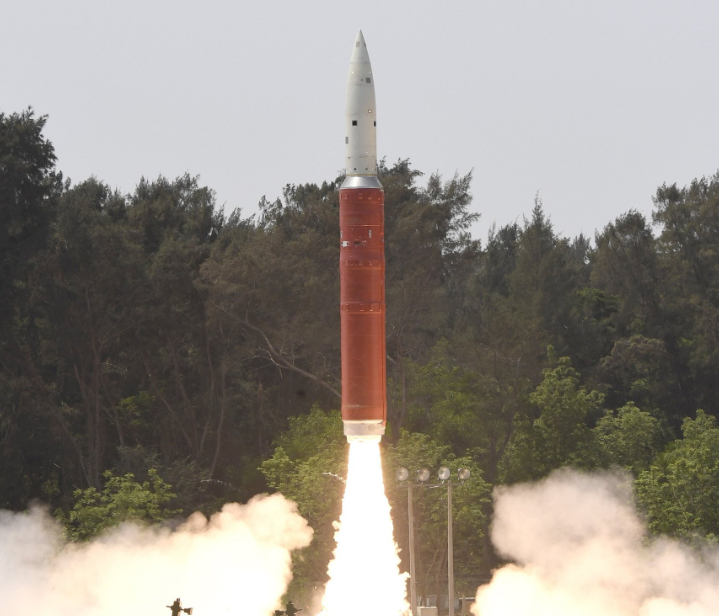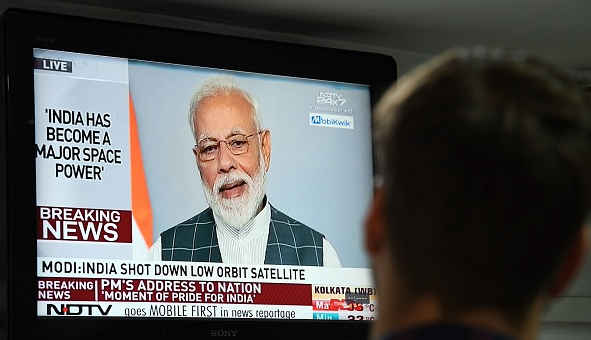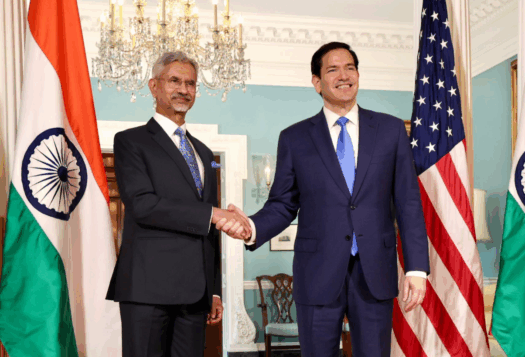
India’s ASAT Test: The Space vs Nuclear Dichotomy
By: Arka Biswas
Announced by Prime Minister Narendra Modi on March 27, India’s recent anti-satellite test not only impacts domestic politics, with national assembly elections upcoming, but has also sparked two interesting streams of conversation among intelligentsia. On the one hand, space experts have focused on how this test indicates India’s ability to deter adversaries from targeting India’s space-based assets. On the other hand, nuclear strategists and scholars are emphasizing that the test contributes to India’s efforts in developing ballistic missile defense (BMD) capabilities. Indeed, a ground-based ballistic missile interceptor, developed by the Defense Research and Development Organization (DRDO) as part of India’s BMD program, was used used to hit a low-orbital Indian satellite. Although the test has implications for both India’s space-based deterrence and BMD capabilities, the reference to augmentation of India’s BMD potential, which the Indian government has categorically avoided in this instance, presents a more destabilizing image.
Prime Minister Modi made the announcement of the test in a nationwide address delivered in Hindi. His sole emphasis was on the vitality of India’s space-based assets in furthering India’s developmental and security needs and how the test ensures the safety of those assets. The government has pitched the test as a deterrent to any adversaries who may seek to attack India’s space-based assets in a conflict. This was evident in the remarks made by Finance Minister Arun Jaitley, who noted: “Just like our nuclear capability, this too is a deterrent capability.”
Even though Modi underlined that the test is not directed against any specific country, China, with its ASAT capabilities demonstrated in 2007, is arguably the nation against which this deterrent is primarily directed. As Indian space scholar Rajeswari Rajagopalan notes, the Chinese ASAT test was a wake-up call for India. In the aftermath of China’s ASAT test, then and former heads of DRDO and the Indian Space Research Organization (ISRO) had argued that India’s space-based assets must be secured.
However, while the Indian government and space scholars have emphasized that the test establishes India’s space-based deterrence, scholars of nuclear strategy have argued that the test supports India’s ongoing efforts towards the development of BMD capabilities. This also ties in with the narrative that India is exploring counterforce options, particularly against Pakistan. Scholar Vipin Narang, of the Massachusetts Institute of Technology, for instance, tweeted: “India’s ASAT test today has huge implications for what Christopher Clary and I wrote on India’s interest in counterforce. One piece is hunting nukes, but the other is intercepting residuals—BMD—so your hunt doesn’t have to be perfect. Today’s test was about BMD.” Narang went on to use Jaitley’s reference to “nuclear” in his speech to substantiate the argument that India is seeking to limit damage to offset Pakistan’s second-strike capability.
While Modi’s speech highlights the government’s attempt at prioritizing national security as an election agenda, emphasis on “pride” arguably diminishes the relative role of imminent external threats as a factor influencing the decision to conduct the ASAT test. Instead, Modi’s address captures prestige as the primary rationale for it.
Notwithstanding the arguments, the two readings offer distinct interpretations of how the test is perceived. Viewing the test as a natural corollary to the Chinese test of 2007 offers a more responsible justification – India seeks to secure its space-based assets from China’s ASAT threat by demonstrating the ability to damage Chinese assets in return, irrespective of how credible the deterrence is. On the other hand, emphasis on augmenting BMD capabilities for damage limitation as part of what some scholars suspect is India’s strategy of eliminating Pakistan’s nuclear assets in a first strike presents a more destabilizing image. It also ties the test to the India-Pakistan conflict dyad. Nevertheless, both these readings are driven by external threats and India’s attempts to address them.
But in his brief address, Modi used the word “गर्व”, which translates to “pride,” thrice. He further noted that only three countries have achieved this feat so far, bringing India to the table with the United States, Russia, and China, and lauded Indian scientists for this accomplishment. While Modi’s speech highlights the government’s attempt at prioritizing national security as an election agenda, emphasis on “pride” arguably diminishes the relative role of imminent external threats as a factor influencing the decision to conduct the ASAT test. Instead, Modi’s address captures prestige as the primary rationale for it. While the test is likely to only marginally influence the outcome of the upcoming elections in Modi’s favor, it captures how national pride and prestige have been a long-term factor in contributing to India’s strategic choices – be it in the nuclear or the space realm.
***

India’s ASAT Test: A Shot in the Dark
By: Sufian Ullah and Irteza Imam
Pakistan-India relations took a dive for the worse this February, as the world witnessed the two nations engage in aerial combat for the first time since the 1971 war. Although the situation somewhat de-escalated, tensions still grip the region. The morning of March 27 added a new layer of complexity when Indian Prime Minister Narendra Modi announced that Indian scientists had successfully destroyed a Low Earth Orbit satellite to demonstrate the country’s anti-satellite (ASAT) capability. For India, the demonstration of this capability has not only technological and claimed deterrent imperatives, but also prestige and pride implications, as professed by Modi in his address. Though the political aspirations underlying this test are somewhat understandable, its pragmatic strategic and military rationale remains vague. While achieving technological parity with China and technological superiority over Pakistan is paramount for India, the ASAT capability could have far reaching consequences for stability in the region.
While we focus on the deterrent role of ASAT, let us not overlook the risk of exacerbation of a crisis due to the presence of such weapons. Even if it might provide reassurance in peacetime, ASAT technology is intrinsically an aggressive weapon that gives a state the capability to blind or disrupt an adversary’s command and control & intelligence, information, surveillance, and reconnaissance (I2SR) capabilities, thus exacerbating any crisis. By impairing an adversary’s ability to effectively retaliate, ASAT amounts to a counterforce weapon, particularly in the nuclear domain. Targeting any satellite, whether military or otherwise, in a crisis could consequently raise nuclear alert levels and could motivate response options that may not be under the confines of the law of proportionality.
Like all military capabilities, the role and significance of ASAT cannot be gauged in isolation. For an ambitious space-faring nation like India, space assets have opened myriad opportunities such as more robust command and control systems, I2SR, navigation, and communications. An ASAT test also demonstrates India’s capability to intercept and destroy a nuclear warhead in mid-course, giving credibility to its development of a multi-tiered, multi-faceted ballistic missile defense (BMD) program. Moreover, this capability reinforces speculation that India is steadily inching towards a counterforce targeting strategy and comes at a time when its policy of “No First Use” (NFU) is being seriously scrutinized by scholars. This aspect further intensifies Pakistan’s security concerns as India’s growing counterforce capabilities further undermine the credibility of its NFU policy and could trigger an arms race in South Asia.
However, Indian ASAT may not be a potent tool to completely deprive its adversary of intelligence and early warning capabilities—doing so is a formidable task especially when countries rely not only on space-based assets but have aerial- and ground-based I2SR systems. One manifestation of this was seen last month when a Pakistani maritime reconnaissance aircraft reportedly detected an Indian submarine.
This capability reinforces speculation that India is steadily inching towards a counterforce targeting strategy and comes at a time when its policy of “No First Use” (NFU) is being seriously scrutinized by scholars. This aspect further intensifies Pakistan’s security concerns as India’s growing counterforce capabilities further undermine the credibility of its NFU policy and could trigger an arms race in South Asia.
Growing ASAT capabilities worldwide also suggest that countries might not overly rely on satellites and rather invest more in aerial or ground based systems to prevent vulnerability. For the Sino-Indian strategic equation, where both are rapidly increasing space capabilities, the implications can be far greater. Once an ASAT is launched, the flight duration gives more time to respond, thus aggravating the situation by compelling the adversary to respond not only in-kind but also in other quicker domains, possibly leading to uncontrollable escalation. As Kurt Gottfried and Richard N. Lebow argued more than three decades ago, if asymmetries between satellite dependence and ASAT capabilities among adversarial states continue to grow, the prospects of mutual deterrence would be undermined.
In summation, India’s testing of this capability at this time might lead to more problems rather than benefits it could reap. The ruling party has faced some backlash with the test being labeled an election stunt by opposition parties and others on social media. The issue of space debris led the United States to issue a statement taking note of the situation. But it was significant for its lack of any real criticism, giving the connotation of indirect U.S. recognition or support of India’s ambitions. For all space faring nations as well as commercial entities, the issue of space debris is a grave one and it is in the interest of all stakeholders to preserve outer space as a global common that remains peaceful.
Click here to read this article in Urdu.
Image 1: Indian Air Force via Twitter
Image 2: Prakash Singh/AFP via Getty Images
***


